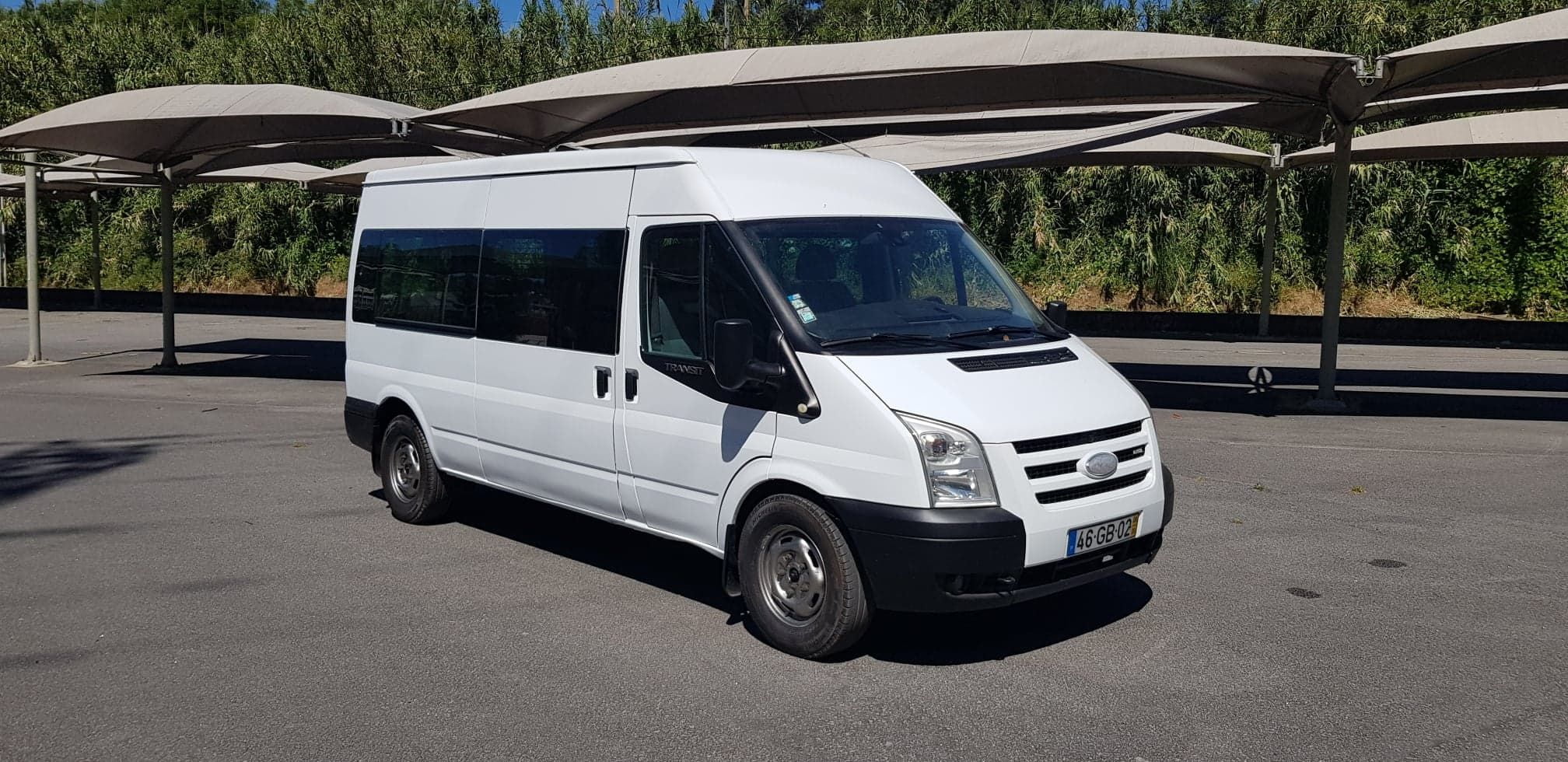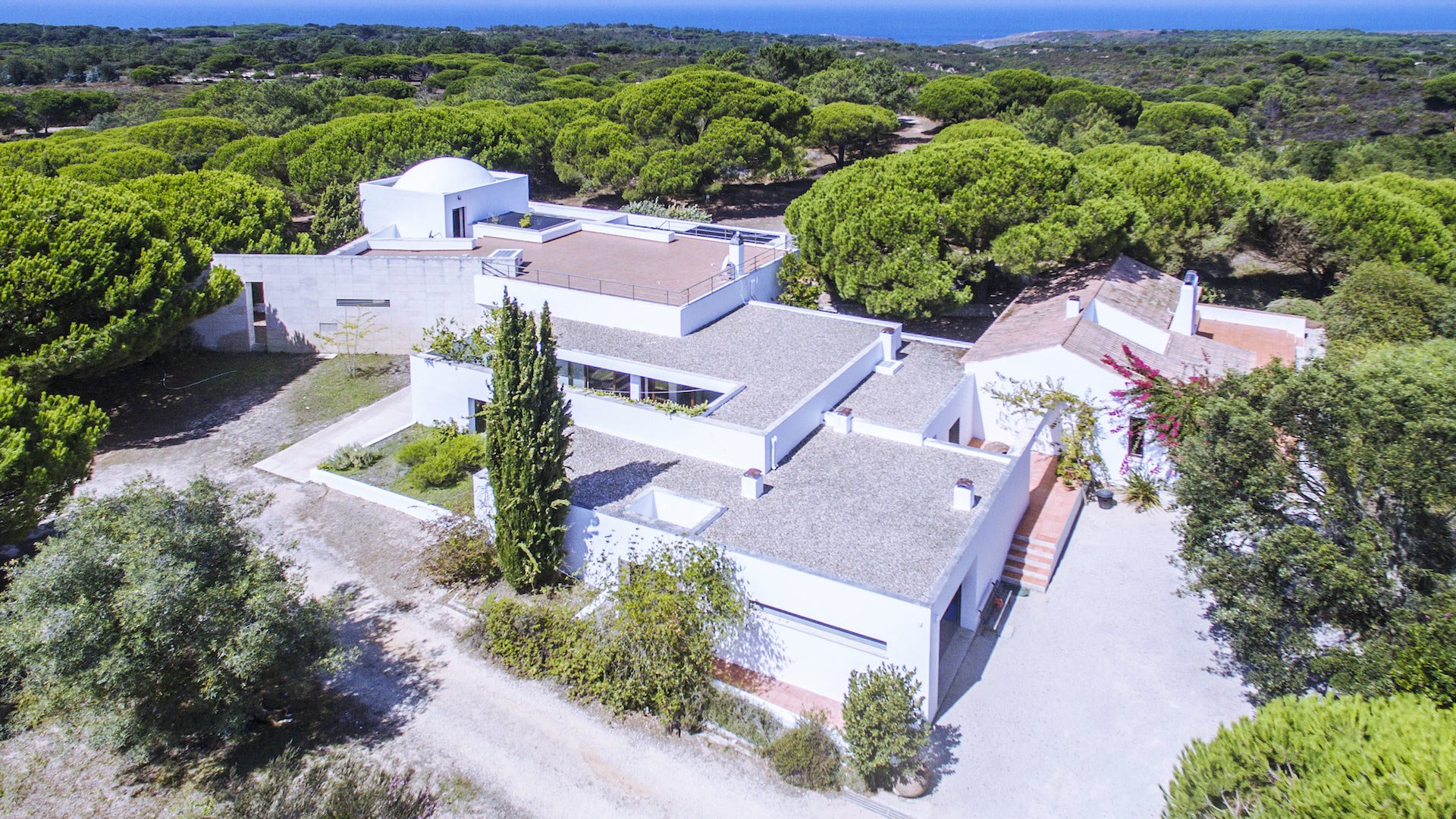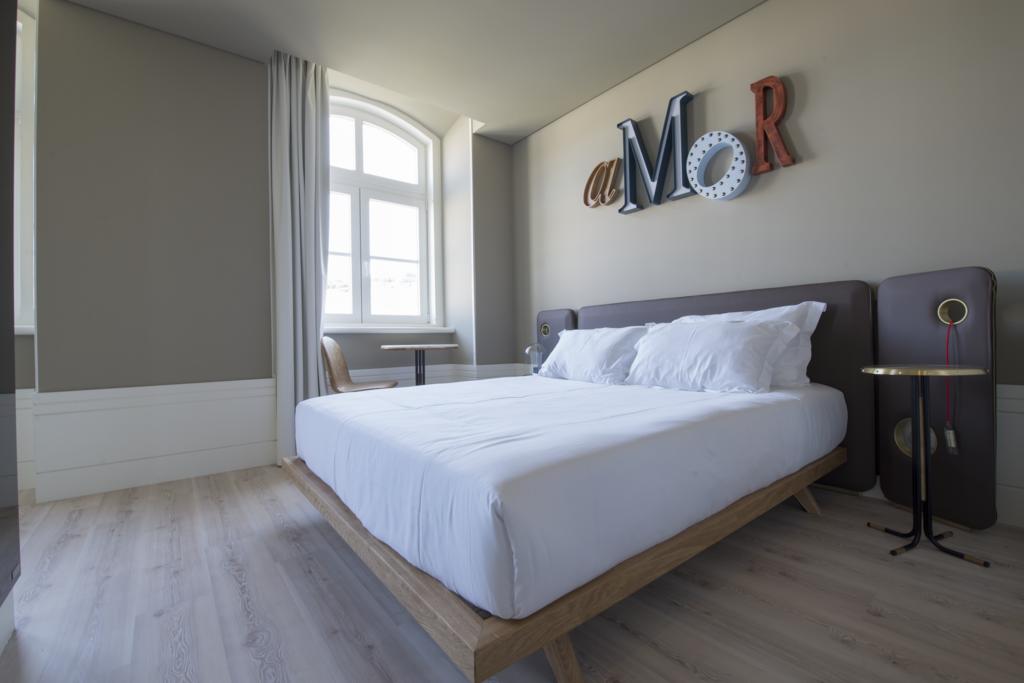Cities to visit in the Algarve
Portugal’s southernmost region, the Algarve, on the Atlantic coast, is probably the most visited and least typical of Portugal. The opening of the international airport in Faro, the region’s capital, in the 1960s brought an influx of visitors and the development of facilities and amenities that have made the region a popular vacation destination. But there is something that sets the Algarve apart from the rest of the country: an almost total absence of buildings older than the mid-18th century, as this is the epicenter of the devastating 1755 earthquake near Lagos. What survived, and the architecture that resulted, bear the mark of a long Islamic presence. Indeed, Abu Jaafar al-Mansur conquered the region in 711, making it part of the Arab caliphate for more than five centuries. It is worth noting at the outset how easy it is to get around the province, due in part to its modest size. The main bus company serving the Algarve is Eva transportes, which provides services within the region as well as to Lisbon and Seville. The trip from the capital to Albufeira, for example, takes almost 3 hours and costs €20, and from Faro to Seville, €18 one way. The south of the country is also accessible by train via the CP (Comboios de Portugal) company, which connects Lisbon to Faro in over three hours and costs €28. In addition, the train line runs along most of the coast from Lagos to Vila Real, on the Spanish border, which is very convenient for exploring the region.
It is worth noting at the outset how easy it is to get around the province, due in part to its modest size. The main bus company serving the Algarve is Eva transportes, which provides services within the region as well as to Lisbon and Seville. The trip from the capital to Albufeira, for example, takes almost 3 hours and costs €20, and from Faro to Seville, €18 one way. The south of the country is also accessible by train via the CP (Comboios de Portugal) company, which connects Lisbon to Faro in over three hours and costs €28. In addition, the train line runs along most of the coast from Lagos to Vila Real, on the Spanish border, which is very convenient for exploring the region. Destroyed first by the English in 1596, then by an earthquake in 1755 and rebuilt in the 18th century, the historic center of the Algarve is a pleasant place to walk around. Small sections of the old walls have survived despite history. Faro‘s archaeological museum houses a small but interesting collection of archaeological finds ranging from Roman mosaics and sculptures to medieval wood carvings. The building itself is also interesting – the museum is housed in the former Franciscan monastery of Nossa Senhora de Assuncao (Igreja de Nossa Senhora da Assuncao)
Destroyed first by the English in 1596, then by an earthquake in 1755 and rebuilt in the 18th century, the historic center of the Algarve is a pleasant place to walk around. Small sections of the old walls have survived despite history. Faro‘s archaeological museum houses a small but interesting collection of archaeological finds ranging from Roman mosaics and sculptures to medieval wood carvings. The building itself is also interesting – the museum is housed in the former Franciscan monastery of Nossa Senhora de Assuncao (Igreja de Nossa Senhora da Assuncao) The Parque Natural da Ria Formosa deserves to be mentioned here because it is a jewel in the crown of the Algarve. It extends over 60 km of coastline and was designed to protect a unique ecosystem.The lagoons, marshes and salt lakes are cut off from the ocean by a chain of islands that are essentially sand dunes. There are many crustaceans, mollusks and oysters, while native bird species and northern European species migrate here for the winter.Many visitors take a day trip to islands such as the uninhabited Deserta Island to enjoy the scenery and beaches, where access is regulated and you can walk around all day without seeing anyone. There is a small café on the island, a developed beach and hiking trails. A round trip costs from 25 euros per person and other excursions can be organized around this emblematic place of the Algarve.
The Parque Natural da Ria Formosa deserves to be mentioned here because it is a jewel in the crown of the Algarve. It extends over 60 km of coastline and was designed to protect a unique ecosystem.The lagoons, marshes and salt lakes are cut off from the ocean by a chain of islands that are essentially sand dunes. There are many crustaceans, mollusks and oysters, while native bird species and northern European species migrate here for the winter.Many visitors take a day trip to islands such as the uninhabited Deserta Island to enjoy the scenery and beaches, where access is regulated and you can walk around all day without seeing anyone. There is a small café on the island, a developed beach and hiking trails. A round trip costs from 25 euros per person and other excursions can be organized around this emblematic place of the Algarve. The small town of Olhão, which also offers an excursion to the Ria Formosa Natural Park, is located 10 km east of Faro and is often called the “fish capital”. Although fishing is widely practiced here, Olhão is the largest center for canning tuna and sardines and is famous for its picturesque fish market. The architecture of the purpose-built complex is remarkable, as the market has been there for over a century.The historic center has several interesting churches, including the Igreja Matriz de Moncarapacho, which dates from the 15th century. Notable for its 16th century portal with sculptures depicting the Annunciation and the apostles Peter and Paul.The parish church of Our Lady of the Rosary (Igreja Nossa Senhora do Rosario) was built with money from local fishermen in the 17th century and is dedicated to “Our Lady of the Rosary who protects against storms and dangers at sea”. Inside, there is a traditional golden altar.
The small town of Olhão, which also offers an excursion to the Ria Formosa Natural Park, is located 10 km east of Faro and is often called the “fish capital”. Although fishing is widely practiced here, Olhão is the largest center for canning tuna and sardines and is famous for its picturesque fish market. The architecture of the purpose-built complex is remarkable, as the market has been there for over a century.The historic center has several interesting churches, including the Igreja Matriz de Moncarapacho, which dates from the 15th century. Notable for its 16th century portal with sculptures depicting the Annunciation and the apostles Peter and Paul.The parish church of Our Lady of the Rosary (Igreja Nossa Senhora do Rosario) was built with money from local fishermen in the 17th century and is dedicated to “Our Lady of the Rosary who protects against storms and dangers at sea”. Inside, there is a traditional golden altar. Pretty, full of old churches and historic buildings, Tavira is considered the most architecturally attractive city in the Algarve. There are 21 churches here but unfortunately, most of them are only open during services. The baroque Church of Mercy (Igreja Misericordia), dating from the 16th century, is an exception.In the old church of Santa Maria do Castelo (Igreja Santa Maria do Castelo), founded in the 13th century on the site of a former mosque, you can see the graves of Don Paio Peres Correia and his seven knights killed by the Moors during the truce.The castle (Castelo de Tavira, free entrance from 10 am to 5 pm) that crowns the hill is often considered a Moorish castle, although some sources believe it was built by the Phoenicians in the 8th century BC. However, the ruins of the fortress, consisting of three towers and the remains of the walls, offer good views of the city.The best view of Tavira is from the Camera Obscura (May to September, 10 a.m. to 8 p.m.; other months until 6 p.m.; €3.50) located in the nearby old water tower.
Pretty, full of old churches and historic buildings, Tavira is considered the most architecturally attractive city in the Algarve. There are 21 churches here but unfortunately, most of them are only open during services. The baroque Church of Mercy (Igreja Misericordia), dating from the 16th century, is an exception.In the old church of Santa Maria do Castelo (Igreja Santa Maria do Castelo), founded in the 13th century on the site of a former mosque, you can see the graves of Don Paio Peres Correia and his seven knights killed by the Moors during the truce.The castle (Castelo de Tavira, free entrance from 10 am to 5 pm) that crowns the hill is often considered a Moorish castle, although some sources believe it was built by the Phoenicians in the 8th century BC. However, the ruins of the fortress, consisting of three towers and the remains of the walls, offer good views of the city.The best view of Tavira is from the Camera Obscura (May to September, 10 a.m. to 8 p.m.; other months until 6 p.m.; €3.50) located in the nearby old water tower. East of Tavira, up to Monte Gordo, 3 km from the Guadiana River, which marks the border with Spain, is a land almost untouched by mass tourism.The quiet atmosphere of the small villages, the smallest of which has only 100 people living from fishing and agriculture, is preserved while the 30 km long coastline is a strip of white sand. Of course, there are no outstanding architectural sites, but there is plenty of room for a quiet, secluded vacation.Activities at Monte Gordo include river cruises, jeep safaris in the protected areas of the eastern Algarve and traditional restaurants.One of the most interesting nature reserves, the Sapal Natural Park (Reserva Natural do Sapal), is located in the salt marsh areas near the village of Castro Marin. It is home to many species of birds, including flamingos and herons, and has the largest population of chameleons in Europe.
East of Tavira, up to Monte Gordo, 3 km from the Guadiana River, which marks the border with Spain, is a land almost untouched by mass tourism.The quiet atmosphere of the small villages, the smallest of which has only 100 people living from fishing and agriculture, is preserved while the 30 km long coastline is a strip of white sand. Of course, there are no outstanding architectural sites, but there is plenty of room for a quiet, secluded vacation.Activities at Monte Gordo include river cruises, jeep safaris in the protected areas of the eastern Algarve and traditional restaurants.One of the most interesting nature reserves, the Sapal Natural Park (Reserva Natural do Sapal), is located in the salt marsh areas near the village of Castro Marin. It is home to many species of birds, including flamingos and herons, and has the largest population of chameleons in Europe. Albufeira was already favored by the Romans, who built a fortress there that the Arabs later named Al Bukhar (castle on the sea). The city’s reputation as a tourist destination is illustrated by the fact that it has more than 20 different beaches, from one of the most picturesque, Praia Marinha, whose bizarre cliffs are featured in all the Algarve’s brochures, to the 6 km long Salgados beach in Armacao-de-Pera.The 20 km stretch of coastline between Albufeira and Carvoeiro contains some of the most interesting beaches, nestled in the yellow cliffs. Most of them can be reached on foot from the road, about 500-600 meters downhill.Swimming is generally safe, but you may encounter sharp rocks and the tide can be quite high. Lifeguards are on duty in the summer in the equipped areas.Much of the center of Albufeira is pedestrianized, with Moorish arcades in the oldest part of the city. The city’s Arab past is visible in the dazzling white flat-roofed houses that slope down to the water. A walk through the center includes visiting some of the churches and climbing the clock tower (Torre de Relogio).The main attraction, however, are the parks and outdoor activities such as Luso Aventura, Zoomarine and horseback riding.
Albufeira was already favored by the Romans, who built a fortress there that the Arabs later named Al Bukhar (castle on the sea). The city’s reputation as a tourist destination is illustrated by the fact that it has more than 20 different beaches, from one of the most picturesque, Praia Marinha, whose bizarre cliffs are featured in all the Algarve’s brochures, to the 6 km long Salgados beach in Armacao-de-Pera.The 20 km stretch of coastline between Albufeira and Carvoeiro contains some of the most interesting beaches, nestled in the yellow cliffs. Most of them can be reached on foot from the road, about 500-600 meters downhill.Swimming is generally safe, but you may encounter sharp rocks and the tide can be quite high. Lifeguards are on duty in the summer in the equipped areas.Much of the center of Albufeira is pedestrianized, with Moorish arcades in the oldest part of the city. The city’s Arab past is visible in the dazzling white flat-roofed houses that slope down to the water. A walk through the center includes visiting some of the churches and climbing the clock tower (Torre de Relogio).The main attraction, however, are the parks and outdoor activities such as Luso Aventura, Zoomarine and horseback riding. Vilamoura has every chance of becoming the largest vacation resort in Portugal. There are four golf courses, tennis courts, an equestrian center and sports facilities. There is a small airstrip and a huge marina: a marina for yachts and boats of all kinds. Offshore fishing and sailing are popular attractions.The Cerro da Vila, a small open-air museum, features Roman ruins from the first century AD.
Vilamoura has every chance of becoming the largest vacation resort in Portugal. There are four golf courses, tennis courts, an equestrian center and sports facilities. There is a small airstrip and a huge marina: a marina for yachts and boats of all kinds. Offshore fishing and sailing are popular attractions.The Cerro da Vila, a small open-air museum, features Roman ruins from the first century AD. This quite ordinary town, located 5 km from the seaside resort of Vale de Lobo, is worth a visit for one of the most interesting sites in the Algarve, the baroque church of Sant LawrenceBuilt in the late 17th century with local donations in honor of the saint, it was not damaged by the earthquake of 1755. The entire structure, including the ceiling and vaults, is covered with blue and white tiles depicting scenes from the life of the saint. It is believed that the panels were made in Lisbon and brought here in the early 18th century.The statue of St. Lawrence is housed in a splendid golden altar.
This quite ordinary town, located 5 km from the seaside resort of Vale de Lobo, is worth a visit for one of the most interesting sites in the Algarve, the baroque church of Sant LawrenceBuilt in the late 17th century with local donations in honor of the saint, it was not damaged by the earthquake of 1755. The entire structure, including the ceiling and vaults, is covered with blue and white tiles depicting scenes from the life of the saint. It is believed that the panels were made in Lisbon and brought here in the early 18th century.The statue of St. Lawrence is housed in a splendid golden altar. A trip to Almancil can be combined with a visit to Loule. The town’s market, a building from the beginning of the last century with two charming towers crowned with red domes, is a must see. On Saturdays, there is one of the most authentic flea markets, which will delight lovers of old objects.The Arab-built castle dominates the city and the surrounding countryside. The Igreja de Sao Clemente church, dating from the 13th century and later rebuilt, has two splendid side chapels, one entirely tiled in blue and white, similar to that of St. Lawrence in Almancil, the other with a blue and gold baroque altar.
A trip to Almancil can be combined with a visit to Loule. The town’s market, a building from the beginning of the last century with two charming towers crowned with red domes, is a must see. On Saturdays, there is one of the most authentic flea markets, which will delight lovers of old objects.The Arab-built castle dominates the city and the surrounding countryside. The Igreja de Sao Clemente church, dating from the 13th century and later rebuilt, has two splendid side chapels, one entirely tiled in blue and white, similar to that of St. Lawrence in Almancil, the other with a blue and gold baroque altar. Located on the Arade River, Portimao attracted the Romans with its large natural harbor.Today, the city hosts many sailing championships and prestigious car races thanks to the international circuit where many attractions are available such as self-service car rental, driving with an instructor, etc.The old town, centered on the Vasco da Gama pedestrian street, is worth a visit for the ancient Igreja de Nossa Senhora da Conceicao (Church of Nossa Senhora da Conceicao). There are also many stores specializing in leather goods and a 17th century café on the waterfront.
Located on the Arade River, Portimao attracted the Romans with its large natural harbor.Today, the city hosts many sailing championships and prestigious car races thanks to the international circuit where many attractions are available such as self-service car rental, driving with an instructor, etc.The old town, centered on the Vasco da Gama pedestrian street, is worth a visit for the ancient Igreja de Nossa Senhora da Conceicao (Church of Nossa Senhora da Conceicao). There are also many stores specializing in leather goods and a 17th century café on the waterfront. The walk from Portimão to the nearby village of Alvor, 5 km to the west, is one of the best routes to follow, thanks to the promenade that runs along the coast. The fishing village itself is located on the banks of the river of the same name, which forms a large lagoon, and its 3 km long beach (Praia dos Tres Irmaos) is a popular summer destination.The town is dominated by the silhouette of the white Manueline-style church of Divino Salvador (Igreja de Divino Salvador), dating from the 16th century. Boat trips are popular year-round, including to caves hidden in the coastal cliffs.
The walk from Portimão to the nearby village of Alvor, 5 km to the west, is one of the best routes to follow, thanks to the promenade that runs along the coast. The fishing village itself is located on the banks of the river of the same name, which forms a large lagoon, and its 3 km long beach (Praia dos Tres Irmaos) is a popular summer destination.The town is dominated by the silhouette of the white Manueline-style church of Divino Salvador (Igreja de Divino Salvador), dating from the 16th century. Boat trips are popular year-round, including to caves hidden in the coastal cliffs. Lagos, linked to the nearby town of Alvor by the five-kilometer-long Meia Praia beach and its excellent water sports facilities, is a perfect base for a stopover in the Algarve, where beach vacations can be combined with walks through the interesting historic center.The city retains defensive walls and buildings that were originally built by the Arabs in the 8th century, but were modified in the 16th century. The site of one of the most unfortunate incidents in the country’s history is marked by a plaque above the arcades of Rua de Senhora da Graca, where the navigator Nuno Tristano brought the first slaves from the Sahara in 1441 and where a slave market later developed.Boat trips to caves and caverns are also very popular in Lagos, including one under the natural arch of Ponta da Piedade. Some caves can be crossed by boat.The 18th century baroque church of Santo Antonio is a true gem of the Algarve. Eight paintings depicting the miracles of the saint are surrounded by flowers, cherubs and sculptures, a statue of St. Anthony stands above the altar immersed in luxurious gilding and the lower part of the church walls are covered with blue and white azulejos. A small museum displays ancient religious objects, local arts and crafts, and national costumes.
Lagos, linked to the nearby town of Alvor by the five-kilometer-long Meia Praia beach and its excellent water sports facilities, is a perfect base for a stopover in the Algarve, where beach vacations can be combined with walks through the interesting historic center.The city retains defensive walls and buildings that were originally built by the Arabs in the 8th century, but were modified in the 16th century. The site of one of the most unfortunate incidents in the country’s history is marked by a plaque above the arcades of Rua de Senhora da Graca, where the navigator Nuno Tristano brought the first slaves from the Sahara in 1441 and where a slave market later developed.Boat trips to caves and caverns are also very popular in Lagos, including one under the natural arch of Ponta da Piedade. Some caves can be crossed by boat.The 18th century baroque church of Santo Antonio is a true gem of the Algarve. Eight paintings depicting the miracles of the saint are surrounded by flowers, cherubs and sculptures, a statue of St. Anthony stands above the altar immersed in luxurious gilding and the lower part of the church walls are covered with blue and white azulejos. A small museum displays ancient religious objects, local arts and crafts, and national costumes. These 80 meter high cliffs that jut out into the ocean at the southwestern tip of Portugal were called Promontorium Sacrum (Sacred Cape) by the Romans. Over the years, the waves of the Atlantic have carved out deep crevices and caves.Today, the lighthouse, whose light can be seen from 95 km away, is the most powerful landmark for ships in Europe. The body of St. Vincent is said to have washed ashore here, hence the name of the promontory. Excursions are organized here from the Algarve with visits to Lagos, sunset watching, etc. As with Cabo da Roca, a certificate confirming your stay at the far southwestern end of the Eurasian continent can be purchased for €5.The town of Sagres is authentic and has a picturesque marina, secluded beaches that can only be reached by car and a host of renowned surf schools.Henry the Navigator is said to have built a fort, a sailing school and shipyards here. However, all that remains is the great compass rose (Rosa dos Ventos), carved out of stone and measuring 43 meters in diameter.A variety of nautical activities, walks, fishing and adventure excursions are also offered.
These 80 meter high cliffs that jut out into the ocean at the southwestern tip of Portugal were called Promontorium Sacrum (Sacred Cape) by the Romans. Over the years, the waves of the Atlantic have carved out deep crevices and caves.Today, the lighthouse, whose light can be seen from 95 km away, is the most powerful landmark for ships in Europe. The body of St. Vincent is said to have washed ashore here, hence the name of the promontory. Excursions are organized here from the Algarve with visits to Lagos, sunset watching, etc. As with Cabo da Roca, a certificate confirming your stay at the far southwestern end of the Eurasian continent can be purchased for €5.The town of Sagres is authentic and has a picturesque marina, secluded beaches that can only be reached by car and a host of renowned surf schools.Henry the Navigator is said to have built a fort, a sailing school and shipyards here. However, all that remains is the great compass rose (Rosa dos Ventos), carved out of stone and measuring 43 meters in diameter.A variety of nautical activities, walks, fishing and adventure excursions are also offered.
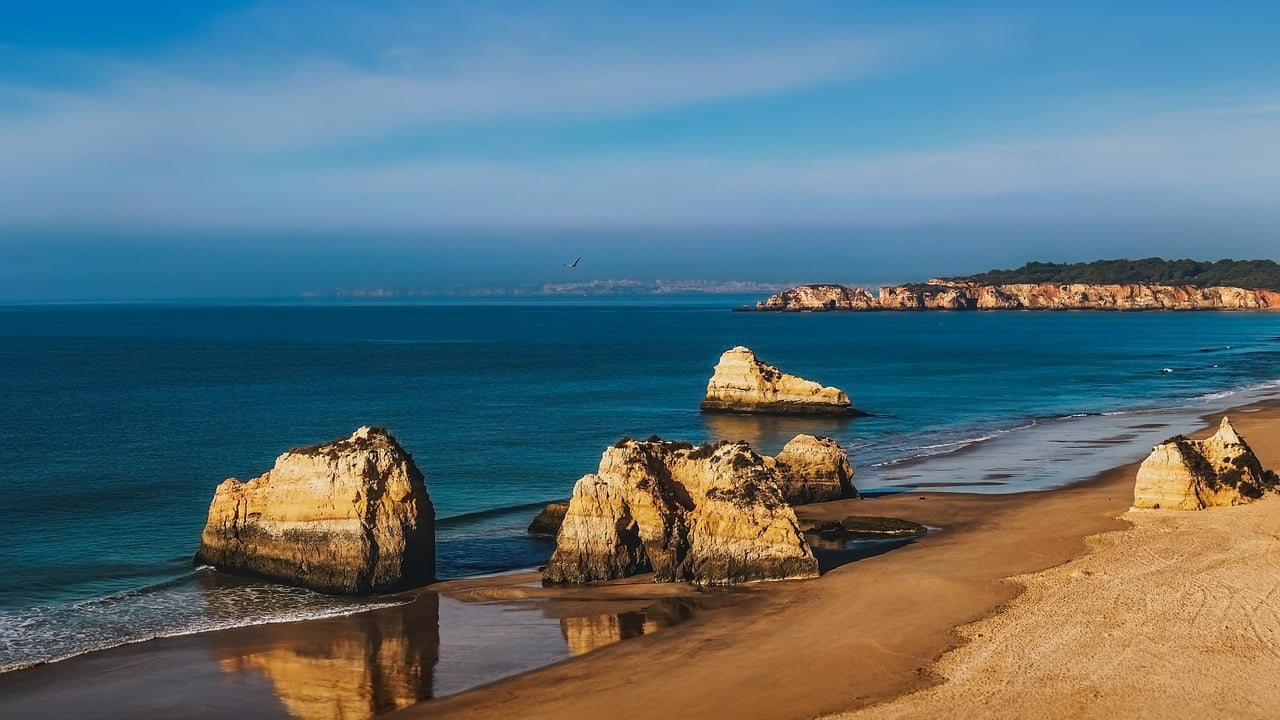 It is worth noting at the outset how easy it is to get around the province, due in part to its modest size. The main bus company serving the Algarve is Eva transportes, which provides services within the region as well as to Lisbon and Seville. The trip from the capital to Albufeira, for example, takes almost 3 hours and costs €20, and from Faro to Seville, €18 one way. The south of the country is also accessible by train via the CP (Comboios de Portugal) company, which connects Lisbon to Faro in over three hours and costs €28. In addition, the train line runs along most of the coast from Lagos to Vila Real, on the Spanish border, which is very convenient for exploring the region.
It is worth noting at the outset how easy it is to get around the province, due in part to its modest size. The main bus company serving the Algarve is Eva transportes, which provides services within the region as well as to Lisbon and Seville. The trip from the capital to Albufeira, for example, takes almost 3 hours and costs €20, and from Faro to Seville, €18 one way. The south of the country is also accessible by train via the CP (Comboios de Portugal) company, which connects Lisbon to Faro in over three hours and costs €28. In addition, the train line runs along most of the coast from Lagos to Vila Real, on the Spanish border, which is very convenient for exploring the region.Before following this page and learning more about the main cities of Portugal to visit, you should know that you will find in the main menu a ” booking ” section in which you can discover my selection of the best activities or hotels in the Algarve. You can book in 3 clicks and plan your vacation.
Faro
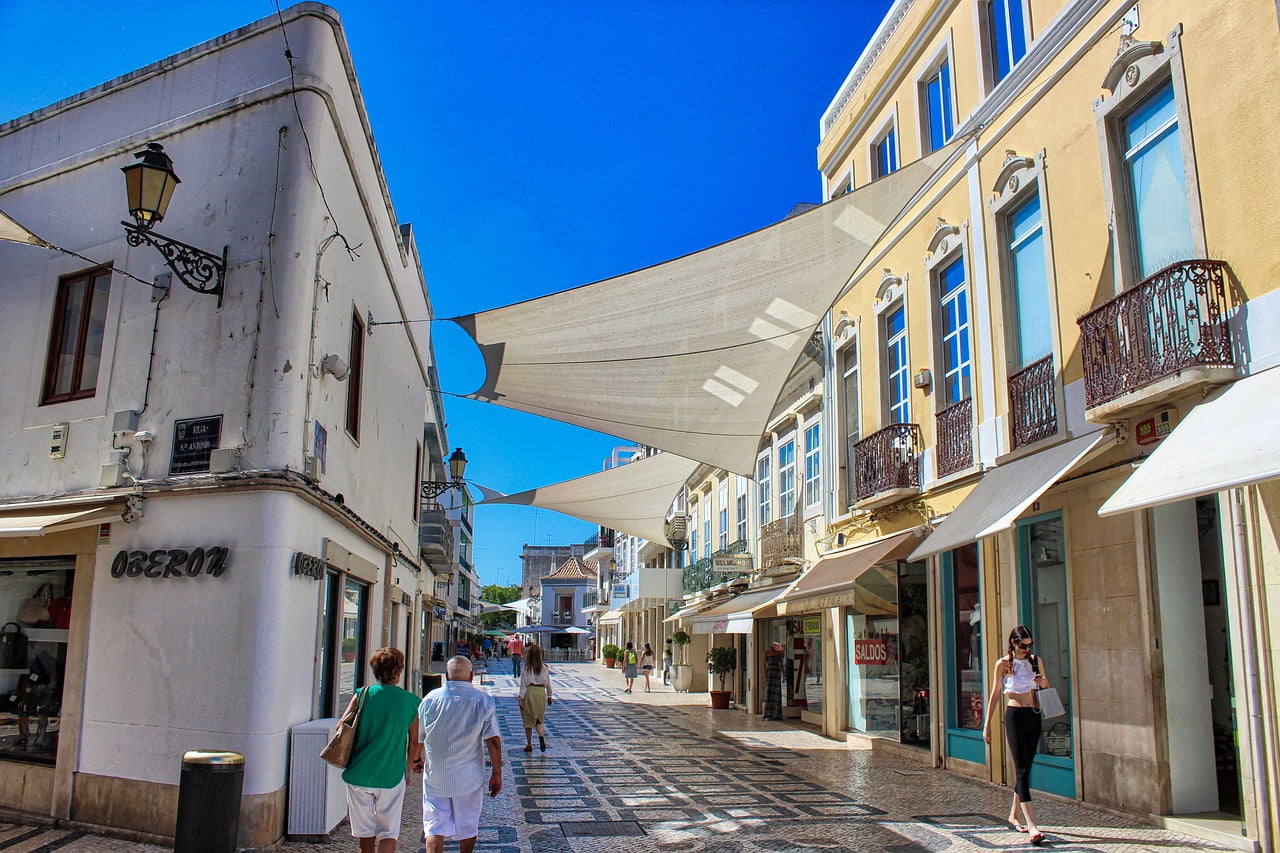 Destroyed first by the English in 1596, then by an earthquake in 1755 and rebuilt in the 18th century, the historic center of the Algarve is a pleasant place to walk around. Small sections of the old walls have survived despite history. Faro‘s archaeological museum houses a small but interesting collection of archaeological finds ranging from Roman mosaics and sculptures to medieval wood carvings. The building itself is also interesting – the museum is housed in the former Franciscan monastery of Nossa Senhora de Assuncao (Igreja de Nossa Senhora da Assuncao)
Destroyed first by the English in 1596, then by an earthquake in 1755 and rebuilt in the 18th century, the historic center of the Algarve is a pleasant place to walk around. Small sections of the old walls have survived despite history. Faro‘s archaeological museum houses a small but interesting collection of archaeological finds ranging from Roman mosaics and sculptures to medieval wood carvings. The building itself is also interesting – the museum is housed in the former Franciscan monastery of Nossa Senhora de Assuncao (Igreja de Nossa Senhora da Assuncao)Faro Archaeological Museum: Open from October to May from 10 am to 5 pm, from June to September from 10 am to 7 pm. The entrance is 2 € and free on Sunday afternoon. Address Largo Afonso III, nº 14 8000-167 Faro. Telephone +351 289 870 827/9.You can also climb the bell tower of the cathedral to admire the spectacular view. This is the first church, built here in honor of the Virgin Mary in the 13th century. It did not escape the fate of most buildings and was rebuilt several times. The current building dates from the 18th century and has a gilded altar, old azulejos and a large organ.
Faro Cathedral: Open Monday to Saturday from 10 am to 5:30 pm. To go up, you have to pay 3€. Address Largo da Sé 11, 8000-138 Faro.The interior of the imposing baroque church of the Carmelites is rich in golden decorations. Don’t miss the little secret of the Chapel of the Bones (Capela dos Ossos), whose walls are made up of the bones of 1200 monks.
Igreja de Nossa Senhora do Carmo: Open weekdays from 10 am to 1 pm and Saturdays from 3 pm to 6 pm. Entrance fee to the chapel of 1 €. Address Largo do Carmo, 8000-148 Faro. Telephone +351 289 823 018.The science center, housed in a former power plant, is not just for physics and experiment enthusiasts. There are aquariums, tanks where you can touch sea creatures, an observatory, an earthquake simulator and many facilities for various experiments… Time flies, especially if you are traveling with children.
Centro Ciencia Viva do Algarve: Open Tuesday through Sunday from 10 am to 6 pm. Admission costs €8 per family or €4 per adult. Address R. Cmte. Francisco Manuel s/n, 8000-250 Faro. Phone +351 289 890 920.In the village of Estoi, 7 km north of Faro, you can take a beautiful walk through a 1st century Roman street, surrounded by orange trees. An open-air museum, this complex is known as the ruins of Mulreu. There are the remains of a large residential building and a huge complex of Roman baths. It takes 20 minutes and 3.25 € to reach the village by cab or bus.
Ruinas de Milreu: Open from April to September from 9:30 am to 12:30 pm and from 2 pm to 6 pm. Open from October to March at 5 pm, closed on Mondays. The entrance fee is 2,50 €. Address 8005-411 Estoi.Also worth mentioning is the Praia de Faro beach, located on the narrow isthmus that separates the lagoon from the sea, and the excellent conditions for playing golf. Windsurfing and horseback riding are very common in the Algarve. Interesting itineraries are available on the official website of the Camara Municipal de Faro.
Ria Formosa Reserve
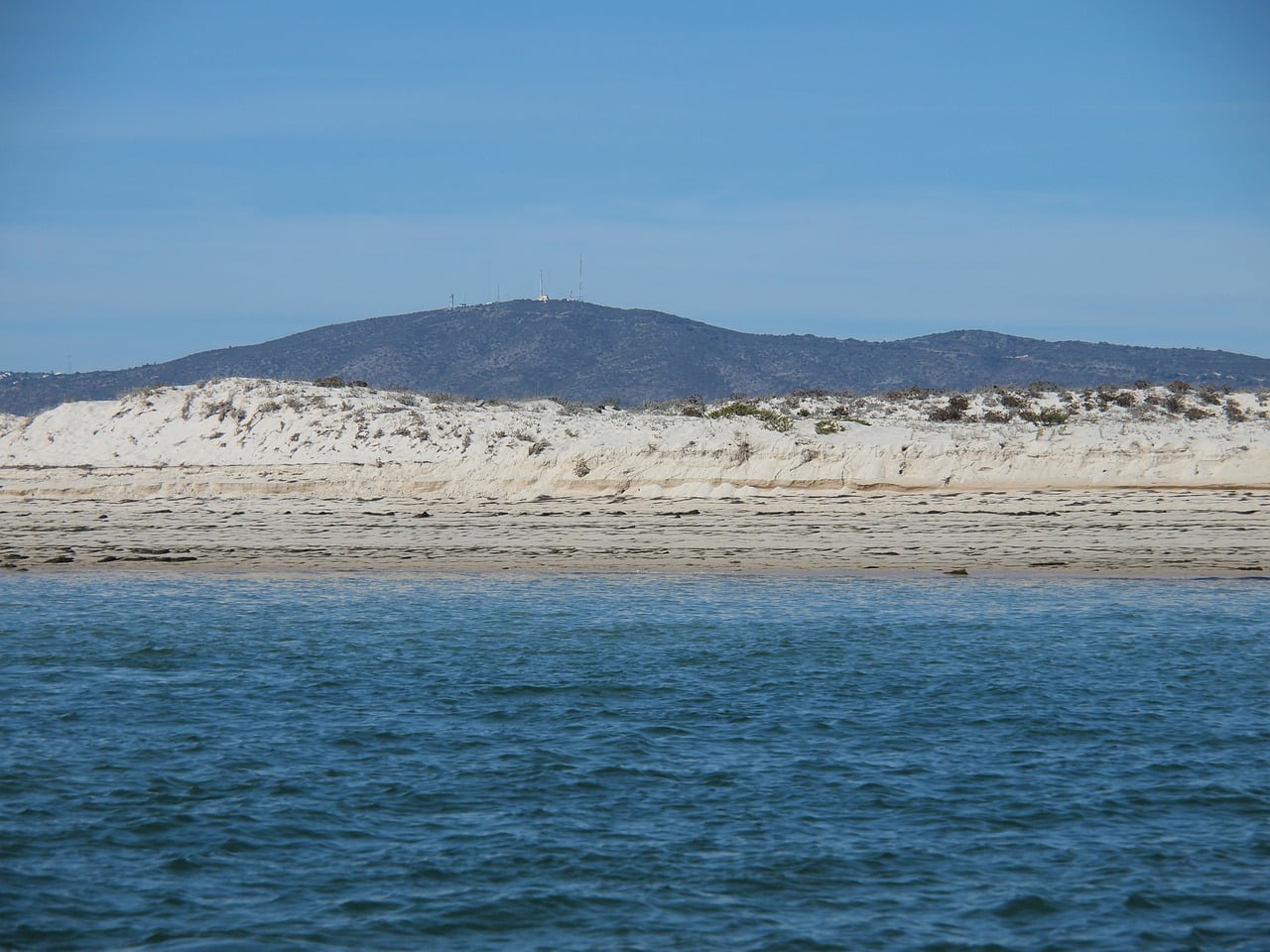 The Parque Natural da Ria Formosa deserves to be mentioned here because it is a jewel in the crown of the Algarve. It extends over 60 km of coastline and was designed to protect a unique ecosystem.The lagoons, marshes and salt lakes are cut off from the ocean by a chain of islands that are essentially sand dunes. There are many crustaceans, mollusks and oysters, while native bird species and northern European species migrate here for the winter.Many visitors take a day trip to islands such as the uninhabited Deserta Island to enjoy the scenery and beaches, where access is regulated and you can walk around all day without seeing anyone. There is a small café on the island, a developed beach and hiking trails. A round trip costs from 25 euros per person and other excursions can be organized around this emblematic place of the Algarve.
The Parque Natural da Ria Formosa deserves to be mentioned here because it is a jewel in the crown of the Algarve. It extends over 60 km of coastline and was designed to protect a unique ecosystem.The lagoons, marshes and salt lakes are cut off from the ocean by a chain of islands that are essentially sand dunes. There are many crustaceans, mollusks and oysters, while native bird species and northern European species migrate here for the winter.Many visitors take a day trip to islands such as the uninhabited Deserta Island to enjoy the scenery and beaches, where access is regulated and you can walk around all day without seeing anyone. There is a small café on the island, a developed beach and hiking trails. A round trip costs from 25 euros per person and other excursions can be organized around this emblematic place of the Algarve.Olhão
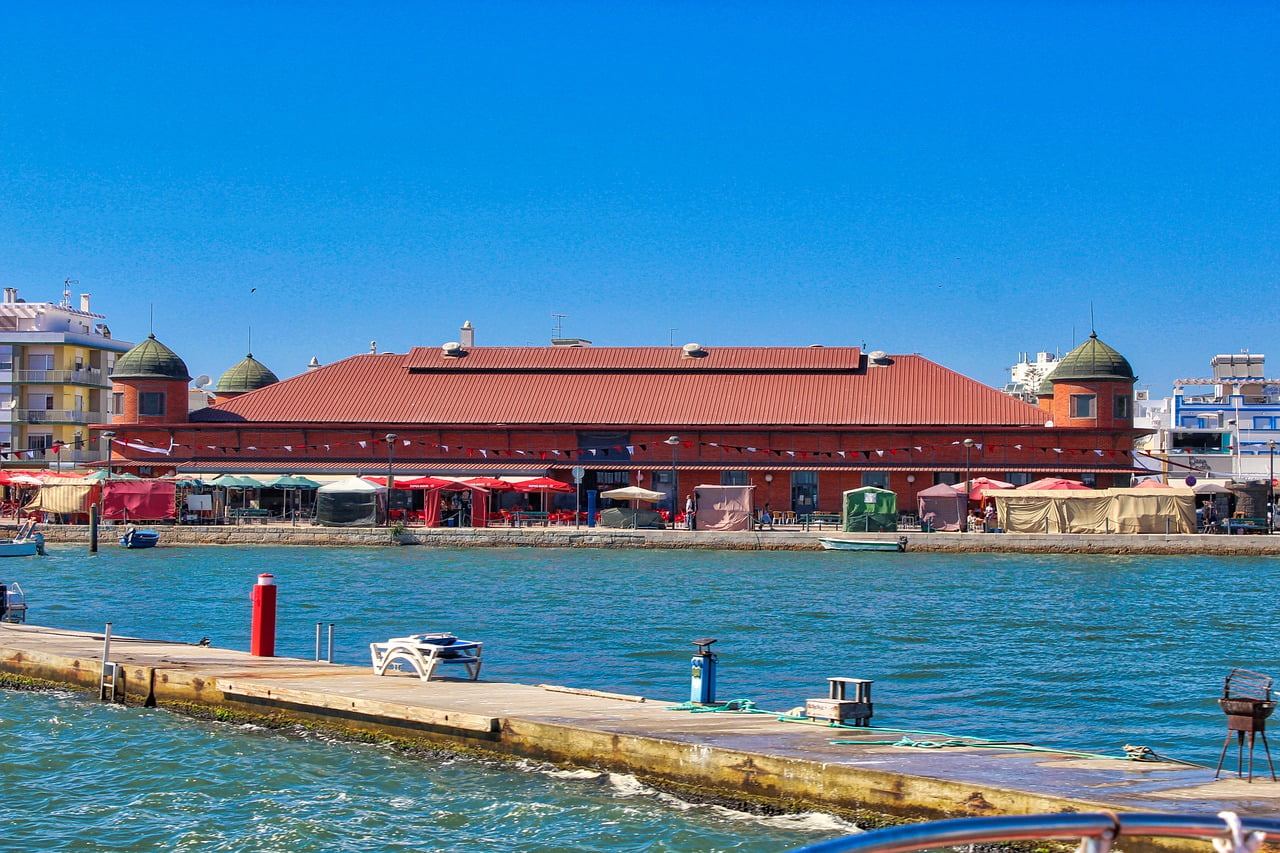 The small town of Olhão, which also offers an excursion to the Ria Formosa Natural Park, is located 10 km east of Faro and is often called the “fish capital”. Although fishing is widely practiced here, Olhão is the largest center for canning tuna and sardines and is famous for its picturesque fish market. The architecture of the purpose-built complex is remarkable, as the market has been there for over a century.The historic center has several interesting churches, including the Igreja Matriz de Moncarapacho, which dates from the 15th century. Notable for its 16th century portal with sculptures depicting the Annunciation and the apostles Peter and Paul.The parish church of Our Lady of the Rosary (Igreja Nossa Senhora do Rosario) was built with money from local fishermen in the 17th century and is dedicated to “Our Lady of the Rosary who protects against storms and dangers at sea”. Inside, there is a traditional golden altar.
The small town of Olhão, which also offers an excursion to the Ria Formosa Natural Park, is located 10 km east of Faro and is often called the “fish capital”. Although fishing is widely practiced here, Olhão is the largest center for canning tuna and sardines and is famous for its picturesque fish market. The architecture of the purpose-built complex is remarkable, as the market has been there for over a century.The historic center has several interesting churches, including the Igreja Matriz de Moncarapacho, which dates from the 15th century. Notable for its 16th century portal with sculptures depicting the Annunciation and the apostles Peter and Paul.The parish church of Our Lady of the Rosary (Igreja Nossa Senhora do Rosario) was built with money from local fishermen in the 17th century and is dedicated to “Our Lady of the Rosary who protects against storms and dangers at sea”. Inside, there is a traditional golden altar.Tavira
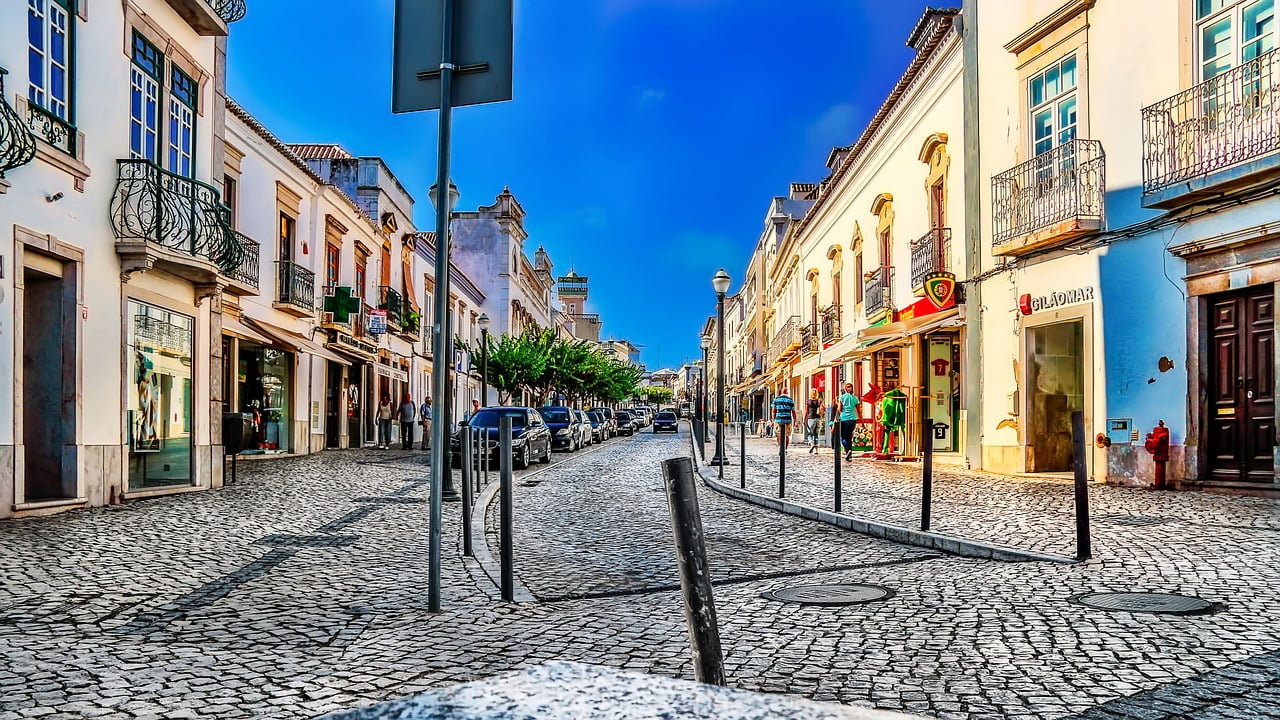 Pretty, full of old churches and historic buildings, Tavira is considered the most architecturally attractive city in the Algarve. There are 21 churches here but unfortunately, most of them are only open during services. The baroque Church of Mercy (Igreja Misericordia), dating from the 16th century, is an exception.In the old church of Santa Maria do Castelo (Igreja Santa Maria do Castelo), founded in the 13th century on the site of a former mosque, you can see the graves of Don Paio Peres Correia and his seven knights killed by the Moors during the truce.The castle (Castelo de Tavira, free entrance from 10 am to 5 pm) that crowns the hill is often considered a Moorish castle, although some sources believe it was built by the Phoenicians in the 8th century BC. However, the ruins of the fortress, consisting of three towers and the remains of the walls, offer good views of the city.The best view of Tavira is from the Camera Obscura (May to September, 10 a.m. to 8 p.m.; other months until 6 p.m.; €3.50) located in the nearby old water tower.
Pretty, full of old churches and historic buildings, Tavira is considered the most architecturally attractive city in the Algarve. There are 21 churches here but unfortunately, most of them are only open during services. The baroque Church of Mercy (Igreja Misericordia), dating from the 16th century, is an exception.In the old church of Santa Maria do Castelo (Igreja Santa Maria do Castelo), founded in the 13th century on the site of a former mosque, you can see the graves of Don Paio Peres Correia and his seven knights killed by the Moors during the truce.The castle (Castelo de Tavira, free entrance from 10 am to 5 pm) that crowns the hill is often considered a Moorish castle, although some sources believe it was built by the Phoenicians in the 8th century BC. However, the ruins of the fortress, consisting of three towers and the remains of the walls, offer good views of the city.The best view of Tavira is from the Camera Obscura (May to September, 10 a.m. to 8 p.m.; other months until 6 p.m.; €3.50) located in the nearby old water tower.Monte Gordo
 East of Tavira, up to Monte Gordo, 3 km from the Guadiana River, which marks the border with Spain, is a land almost untouched by mass tourism.The quiet atmosphere of the small villages, the smallest of which has only 100 people living from fishing and agriculture, is preserved while the 30 km long coastline is a strip of white sand. Of course, there are no outstanding architectural sites, but there is plenty of room for a quiet, secluded vacation.Activities at Monte Gordo include river cruises, jeep safaris in the protected areas of the eastern Algarve and traditional restaurants.One of the most interesting nature reserves, the Sapal Natural Park (Reserva Natural do Sapal), is located in the salt marsh areas near the village of Castro Marin. It is home to many species of birds, including flamingos and herons, and has the largest population of chameleons in Europe.
East of Tavira, up to Monte Gordo, 3 km from the Guadiana River, which marks the border with Spain, is a land almost untouched by mass tourism.The quiet atmosphere of the small villages, the smallest of which has only 100 people living from fishing and agriculture, is preserved while the 30 km long coastline is a strip of white sand. Of course, there are no outstanding architectural sites, but there is plenty of room for a quiet, secluded vacation.Activities at Monte Gordo include river cruises, jeep safaris in the protected areas of the eastern Algarve and traditional restaurants.One of the most interesting nature reserves, the Sapal Natural Park (Reserva Natural do Sapal), is located in the salt marsh areas near the village of Castro Marin. It is home to many species of birds, including flamingos and herons, and has the largest population of chameleons in Europe.Albufeira
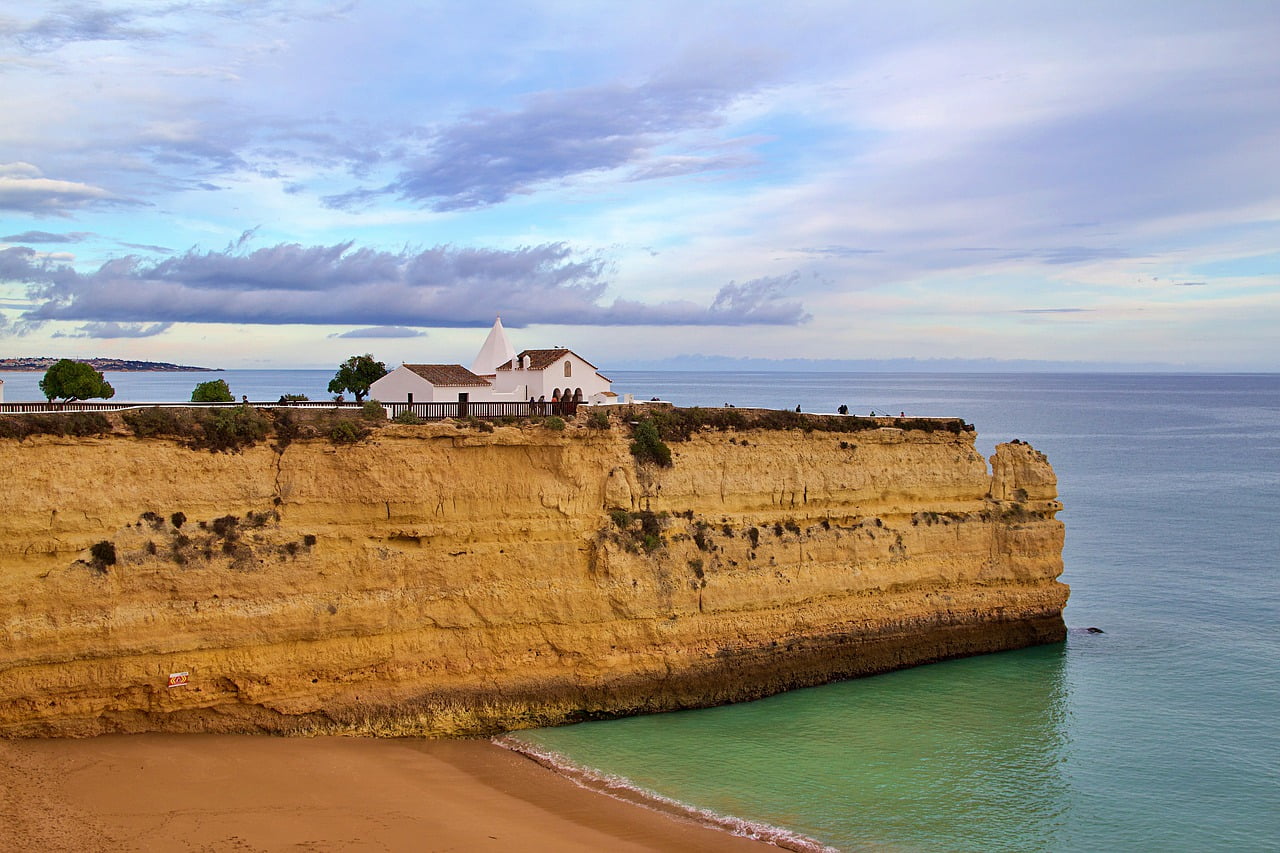 Albufeira was already favored by the Romans, who built a fortress there that the Arabs later named Al Bukhar (castle on the sea). The city’s reputation as a tourist destination is illustrated by the fact that it has more than 20 different beaches, from one of the most picturesque, Praia Marinha, whose bizarre cliffs are featured in all the Algarve’s brochures, to the 6 km long Salgados beach in Armacao-de-Pera.The 20 km stretch of coastline between Albufeira and Carvoeiro contains some of the most interesting beaches, nestled in the yellow cliffs. Most of them can be reached on foot from the road, about 500-600 meters downhill.Swimming is generally safe, but you may encounter sharp rocks and the tide can be quite high. Lifeguards are on duty in the summer in the equipped areas.Much of the center of Albufeira is pedestrianized, with Moorish arcades in the oldest part of the city. The city’s Arab past is visible in the dazzling white flat-roofed houses that slope down to the water. A walk through the center includes visiting some of the churches and climbing the clock tower (Torre de Relogio).The main attraction, however, are the parks and outdoor activities such as Luso Aventura, Zoomarine and horseback riding.
Albufeira was already favored by the Romans, who built a fortress there that the Arabs later named Al Bukhar (castle on the sea). The city’s reputation as a tourist destination is illustrated by the fact that it has more than 20 different beaches, from one of the most picturesque, Praia Marinha, whose bizarre cliffs are featured in all the Algarve’s brochures, to the 6 km long Salgados beach in Armacao-de-Pera.The 20 km stretch of coastline between Albufeira and Carvoeiro contains some of the most interesting beaches, nestled in the yellow cliffs. Most of them can be reached on foot from the road, about 500-600 meters downhill.Swimming is generally safe, but you may encounter sharp rocks and the tide can be quite high. Lifeguards are on duty in the summer in the equipped areas.Much of the center of Albufeira is pedestrianized, with Moorish arcades in the oldest part of the city. The city’s Arab past is visible in the dazzling white flat-roofed houses that slope down to the water. A walk through the center includes visiting some of the churches and climbing the clock tower (Torre de Relogio).The main attraction, however, are the parks and outdoor activities such as Luso Aventura, Zoomarine and horseback riding.Vilamoura
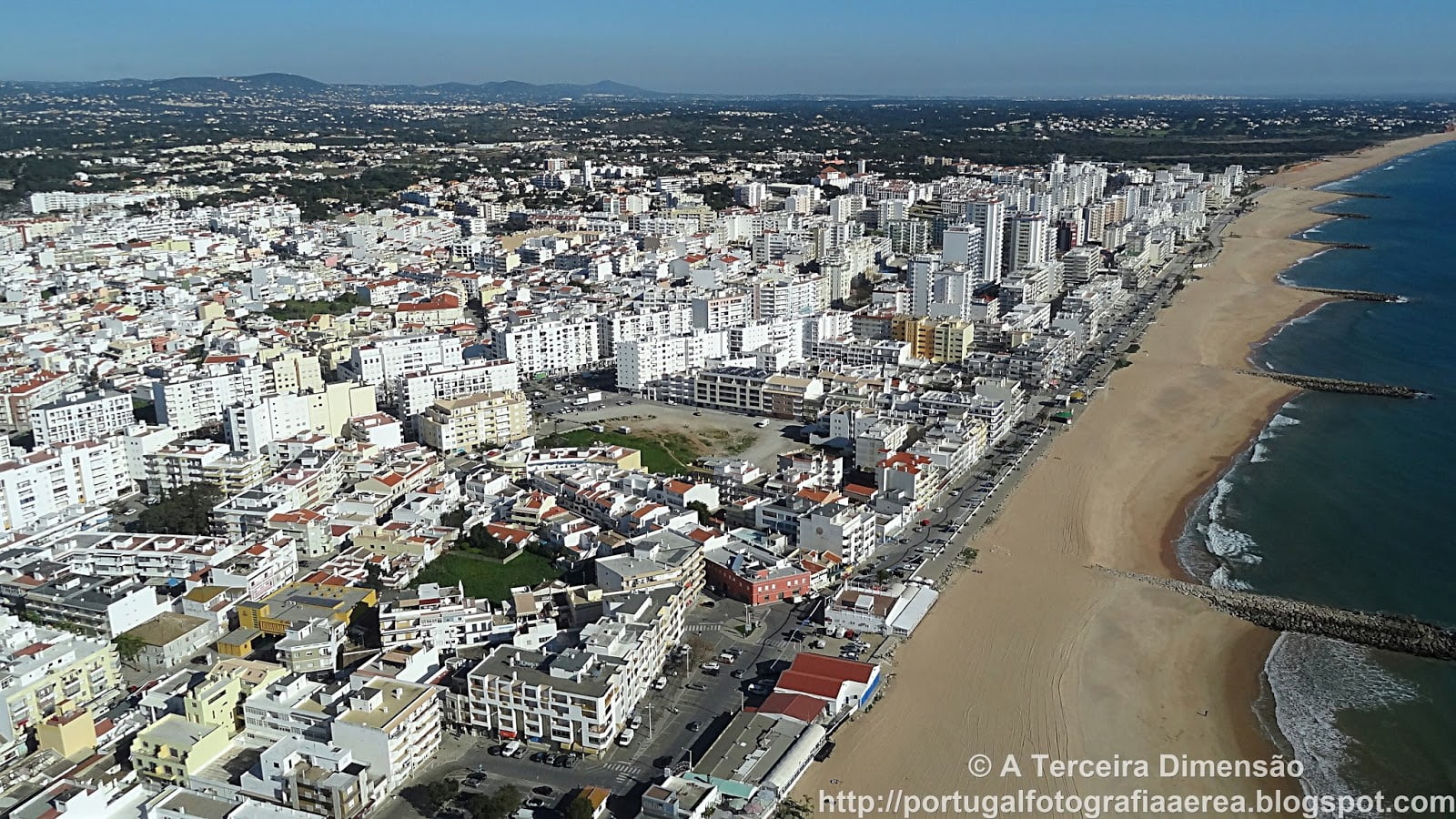 Vilamoura has every chance of becoming the largest vacation resort in Portugal. There are four golf courses, tennis courts, an equestrian center and sports facilities. There is a small airstrip and a huge marina: a marina for yachts and boats of all kinds. Offshore fishing and sailing are popular attractions.The Cerro da Vila, a small open-air museum, features Roman ruins from the first century AD.
Vilamoura has every chance of becoming the largest vacation resort in Portugal. There are four golf courses, tennis courts, an equestrian center and sports facilities. There is a small airstrip and a huge marina: a marina for yachts and boats of all kinds. Offshore fishing and sailing are popular attractions.The Cerro da Vila, a small open-air museum, features Roman ruins from the first century AD.Almancil
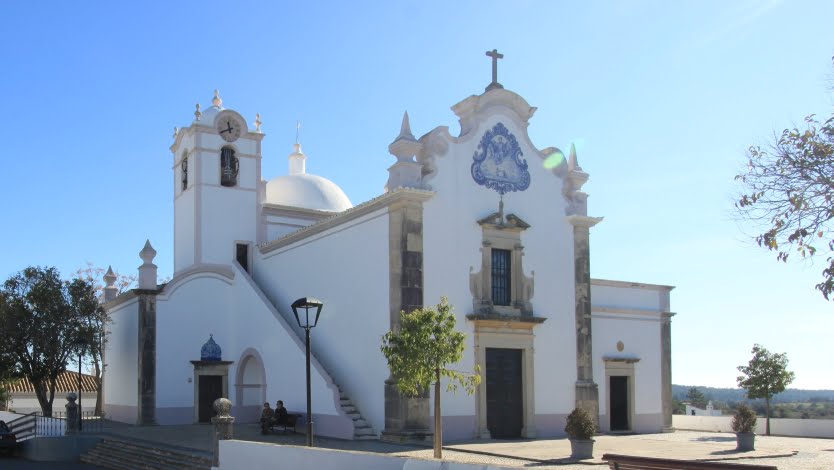 This quite ordinary town, located 5 km from the seaside resort of Vale de Lobo, is worth a visit for one of the most interesting sites in the Algarve, the baroque church of Sant LawrenceBuilt in the late 17th century with local donations in honor of the saint, it was not damaged by the earthquake of 1755. The entire structure, including the ceiling and vaults, is covered with blue and white tiles depicting scenes from the life of the saint. It is believed that the panels were made in Lisbon and brought here in the early 18th century.The statue of St. Lawrence is housed in a splendid golden altar.
This quite ordinary town, located 5 km from the seaside resort of Vale de Lobo, is worth a visit for one of the most interesting sites in the Algarve, the baroque church of Sant LawrenceBuilt in the late 17th century with local donations in honor of the saint, it was not damaged by the earthquake of 1755. The entire structure, including the ceiling and vaults, is covered with blue and white tiles depicting scenes from the life of the saint. It is believed that the panels were made in Lisbon and brought here in the early 18th century.The statue of St. Lawrence is housed in a splendid golden altar.Igreja Matriz de Sao Lourenco: Open Tuesday through Saturday from 10:00 a.m. to 1:00 p.m. and from 2:30 p.m. to 5:00 p.m. Free admission. Address R. da Igreja s/n, 8135-027 Almancil. Telephone +351 289 395 451.
Loule
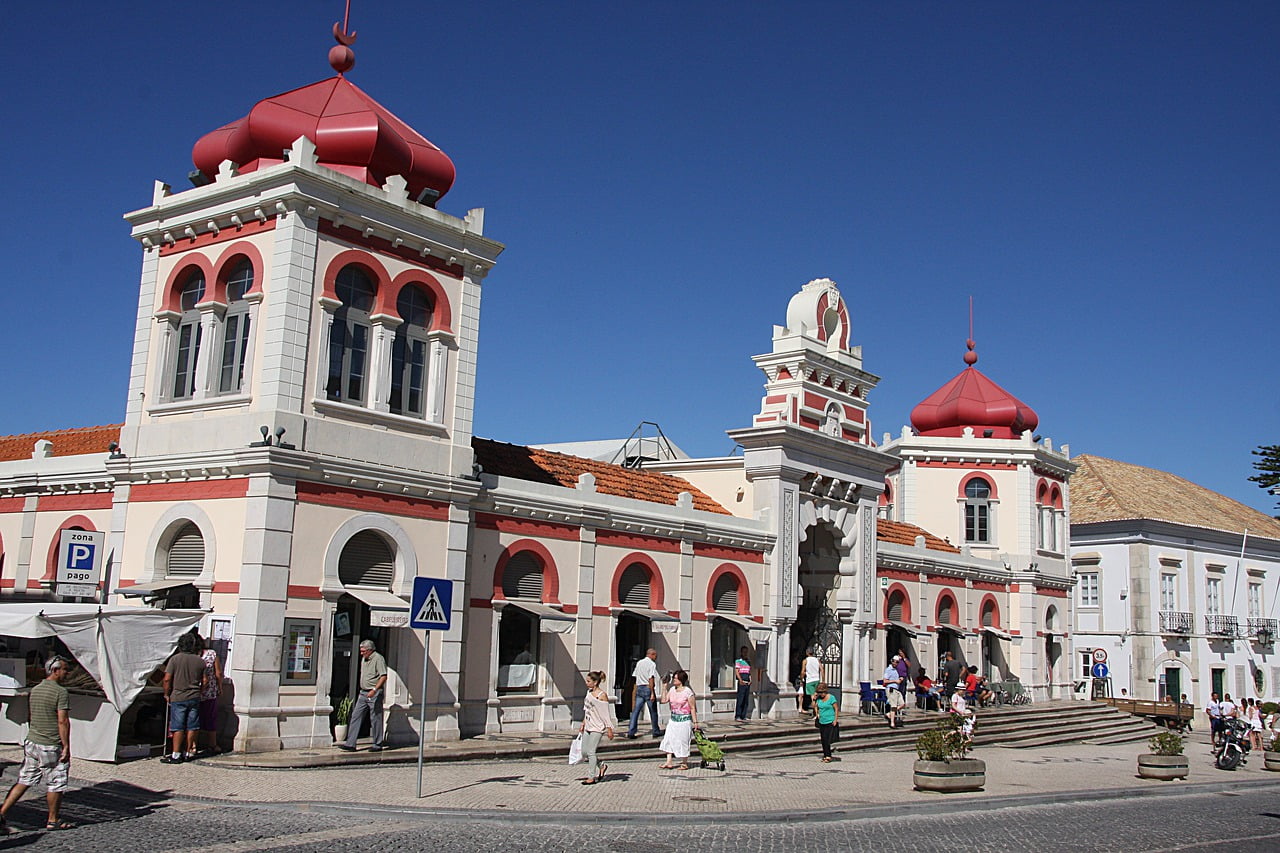 A trip to Almancil can be combined with a visit to Loule. The town’s market, a building from the beginning of the last century with two charming towers crowned with red domes, is a must see. On Saturdays, there is one of the most authentic flea markets, which will delight lovers of old objects.The Arab-built castle dominates the city and the surrounding countryside. The Igreja de Sao Clemente church, dating from the 13th century and later rebuilt, has two splendid side chapels, one entirely tiled in blue and white, similar to that of St. Lawrence in Almancil, the other with a blue and gold baroque altar.
A trip to Almancil can be combined with a visit to Loule. The town’s market, a building from the beginning of the last century with two charming towers crowned with red domes, is a must see. On Saturdays, there is one of the most authentic flea markets, which will delight lovers of old objects.The Arab-built castle dominates the city and the surrounding countryside. The Igreja de Sao Clemente church, dating from the 13th century and later rebuilt, has two splendid side chapels, one entirely tiled in blue and white, similar to that of St. Lawrence in Almancil, the other with a blue and gold baroque altar.Portimao
 Located on the Arade River, Portimao attracted the Romans with its large natural harbor.Today, the city hosts many sailing championships and prestigious car races thanks to the international circuit where many attractions are available such as self-service car rental, driving with an instructor, etc.The old town, centered on the Vasco da Gama pedestrian street, is worth a visit for the ancient Igreja de Nossa Senhora da Conceicao (Church of Nossa Senhora da Conceicao). There are also many stores specializing in leather goods and a 17th century café on the waterfront.
Located on the Arade River, Portimao attracted the Romans with its large natural harbor.Today, the city hosts many sailing championships and prestigious car races thanks to the international circuit where many attractions are available such as self-service car rental, driving with an instructor, etc.The old town, centered on the Vasco da Gama pedestrian street, is worth a visit for the ancient Igreja de Nossa Senhora da Conceicao (Church of Nossa Senhora da Conceicao). There are also many stores specializing in leather goods and a 17th century café on the waterfront.Alvor
 The walk from Portimão to the nearby village of Alvor, 5 km to the west, is one of the best routes to follow, thanks to the promenade that runs along the coast. The fishing village itself is located on the banks of the river of the same name, which forms a large lagoon, and its 3 km long beach (Praia dos Tres Irmaos) is a popular summer destination.The town is dominated by the silhouette of the white Manueline-style church of Divino Salvador (Igreja de Divino Salvador), dating from the 16th century. Boat trips are popular year-round, including to caves hidden in the coastal cliffs.
The walk from Portimão to the nearby village of Alvor, 5 km to the west, is one of the best routes to follow, thanks to the promenade that runs along the coast. The fishing village itself is located on the banks of the river of the same name, which forms a large lagoon, and its 3 km long beach (Praia dos Tres Irmaos) is a popular summer destination.The town is dominated by the silhouette of the white Manueline-style church of Divino Salvador (Igreja de Divino Salvador), dating from the 16th century. Boat trips are popular year-round, including to caves hidden in the coastal cliffs.Lagos
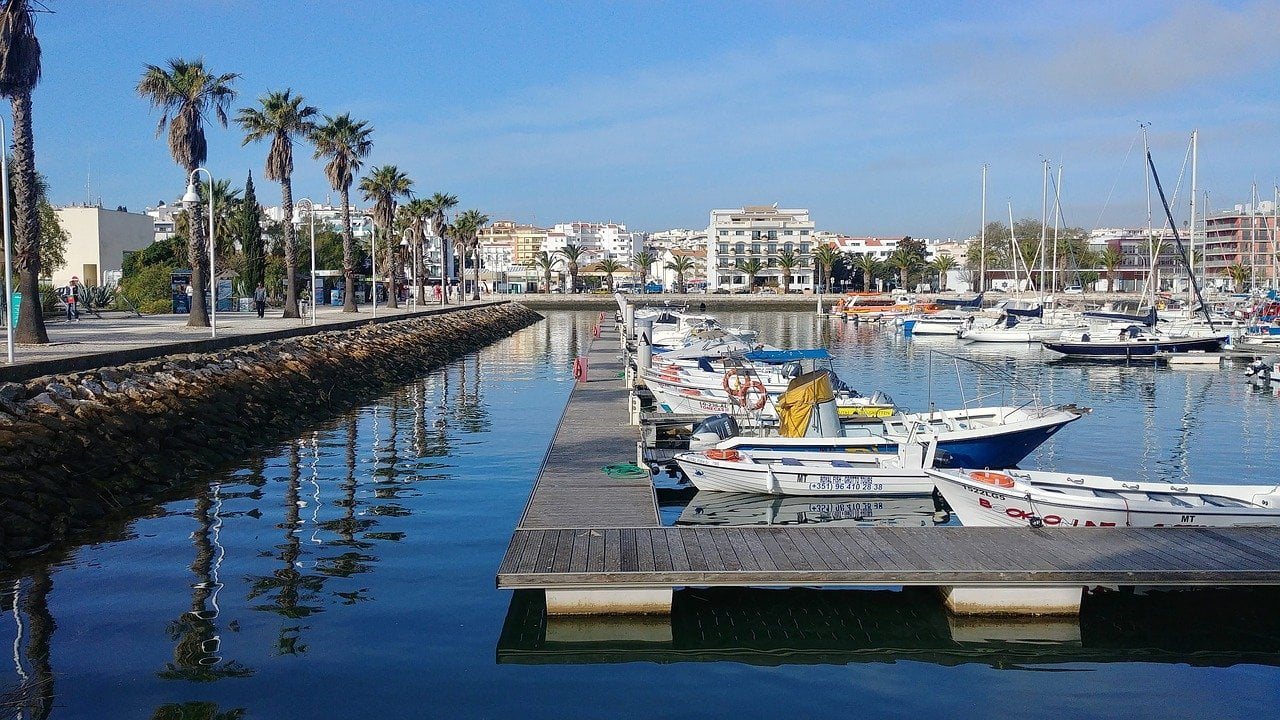 Lagos, linked to the nearby town of Alvor by the five-kilometer-long Meia Praia beach and its excellent water sports facilities, is a perfect base for a stopover in the Algarve, where beach vacations can be combined with walks through the interesting historic center.The city retains defensive walls and buildings that were originally built by the Arabs in the 8th century, but were modified in the 16th century. The site of one of the most unfortunate incidents in the country’s history is marked by a plaque above the arcades of Rua de Senhora da Graca, where the navigator Nuno Tristano brought the first slaves from the Sahara in 1441 and where a slave market later developed.Boat trips to caves and caverns are also very popular in Lagos, including one under the natural arch of Ponta da Piedade. Some caves can be crossed by boat.The 18th century baroque church of Santo Antonio is a true gem of the Algarve. Eight paintings depicting the miracles of the saint are surrounded by flowers, cherubs and sculptures, a statue of St. Anthony stands above the altar immersed in luxurious gilding and the lower part of the church walls are covered with blue and white azulejos. A small museum displays ancient religious objects, local arts and crafts, and national costumes.
Lagos, linked to the nearby town of Alvor by the five-kilometer-long Meia Praia beach and its excellent water sports facilities, is a perfect base for a stopover in the Algarve, where beach vacations can be combined with walks through the interesting historic center.The city retains defensive walls and buildings that were originally built by the Arabs in the 8th century, but were modified in the 16th century. The site of one of the most unfortunate incidents in the country’s history is marked by a plaque above the arcades of Rua de Senhora da Graca, where the navigator Nuno Tristano brought the first slaves from the Sahara in 1441 and where a slave market later developed.Boat trips to caves and caverns are also very popular in Lagos, including one under the natural arch of Ponta da Piedade. Some caves can be crossed by boat.The 18th century baroque church of Santo Antonio is a true gem of the Algarve. Eight paintings depicting the miracles of the saint are surrounded by flowers, cherubs and sculptures, a statue of St. Anthony stands above the altar immersed in luxurious gilding and the lower part of the church walls are covered with blue and white azulejos. A small museum displays ancient religious objects, local arts and crafts, and national costumes.Santo Antonio Church : Open from 10 h to 17 h 30. Entrance at 3€, museum included. Adresse R. Gen. Alberto da Silveira 1, 8600-594 Lagos.On the waterfront are the remains of the 17th century Forte Ponta da Bandeira, which once defended the city. Although today only the walls remain, the site is worth a visit for its spectacular views of the city and the bay.The Lagos Science Museum is a great place to visit with children. There are models of boats, submarines, yachts, lighthouses and a pirate ship, and learning is done in a fun way.
Sagres and the Cape of Cabo de Sao Vicente
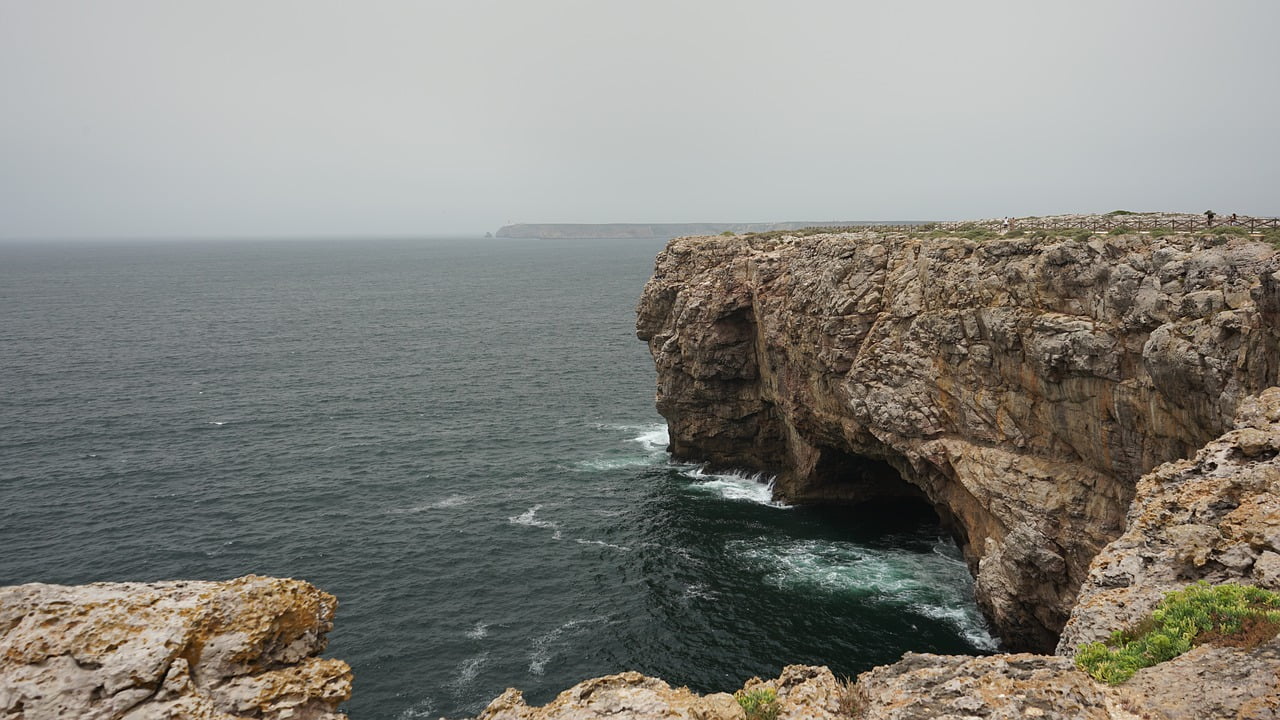 These 80 meter high cliffs that jut out into the ocean at the southwestern tip of Portugal were called Promontorium Sacrum (Sacred Cape) by the Romans. Over the years, the waves of the Atlantic have carved out deep crevices and caves.Today, the lighthouse, whose light can be seen from 95 km away, is the most powerful landmark for ships in Europe. The body of St. Vincent is said to have washed ashore here, hence the name of the promontory. Excursions are organized here from the Algarve with visits to Lagos, sunset watching, etc. As with Cabo da Roca, a certificate confirming your stay at the far southwestern end of the Eurasian continent can be purchased for €5.The town of Sagres is authentic and has a picturesque marina, secluded beaches that can only be reached by car and a host of renowned surf schools.Henry the Navigator is said to have built a fort, a sailing school and shipyards here. However, all that remains is the great compass rose (Rosa dos Ventos), carved out of stone and measuring 43 meters in diameter.A variety of nautical activities, walks, fishing and adventure excursions are also offered.
These 80 meter high cliffs that jut out into the ocean at the southwestern tip of Portugal were called Promontorium Sacrum (Sacred Cape) by the Romans. Over the years, the waves of the Atlantic have carved out deep crevices and caves.Today, the lighthouse, whose light can be seen from 95 km away, is the most powerful landmark for ships in Europe. The body of St. Vincent is said to have washed ashore here, hence the name of the promontory. Excursions are organized here from the Algarve with visits to Lagos, sunset watching, etc. As with Cabo da Roca, a certificate confirming your stay at the far southwestern end of the Eurasian continent can be purchased for €5.The town of Sagres is authentic and has a picturesque marina, secluded beaches that can only be reached by car and a host of renowned surf schools.Henry the Navigator is said to have built a fort, a sailing school and shipyards here. However, all that remains is the great compass rose (Rosa dos Ventos), carved out of stone and measuring 43 meters in diameter.A variety of nautical activities, walks, fishing and adventure excursions are also offered. Related Articles
- Visit Lagos: guided tour of the Algarve in Portugal
To visit Lagos Lagos is the center of the municipality of Lagos in the county…
- Visit Albufeira: guided tour of the Algarve in Portugal
To visit Albufeira Albufeira, once a peaceful fishing village, is now one of the most…
- Visit Faro: guided tour of the Algarve in Portugal
To visit Faro Many vacationers in the Algarve travel to Faro, which is often the…




